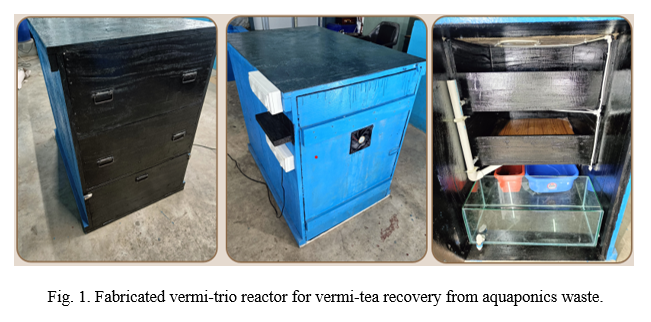VERMI-TEA PRODUCTION FROM FISH WASTE: A SUSTAINABLE APPROACH TO NUTRIENT RECOVERY IN AQUAPONICS
Introduction
Aquaponics systems present a promising solution for sustainable food production by integrating aquaculture and hydroponics. However, managing nutrient cycling and waste reuse remains a critical challenge. One innovative solution involves the incorporation of a vermi-trio reactor that utilizes fish sludge and plant waste for nutrient recovery and ammonia removal. This study explores the development and integration of such a reactor into an aquaponics setup, emphasizing the conversion of system-derived organic waste into valuable biofertilizers—vermicompost, vermiwash, and vermi-tea superior to its conventional counterparts (i.e. vermicompost system etc.). This closed-loop approach not only optimizes resource use efficiency but also reduces environmental impact and the dependency on synthetic inputs, making aquaponics more sustainable and economically viable.
Materials and methods
The vermi-trio reactor was conceptualized focusing on a vertically stacked tray design to conserve space and enhance process efficiency. The structure was fabricated using durable wooden trays, selected for their cost-effectiveness and structural stability. To improve resistance against decomposition during composting, each tray was coated with two layers of plastic-based paint. The reactor accommodates the efficient transformation of fish sludge and plant waste into biofertilizers through vermicomposting. To ensure optimal functioning, the system is operated under controlled conditions suitable for Eisenia fetida, the earthworm species used for decomposition. An automated sensor system monitors and regulates environmental conditions, maintaining a temperature of 25–30°C and relative humidity of 50–70%, which are critical for efficient microbial activity and earthworm performance.
Results
A small scale earthen pot setup was used for producing vermicompost using fish sludge and plant waste from the aquaponics system. The resulting vermicompost was nutrient-rich, containing phosphorus (0.455%), organic carbon (21.74%), and manganese (494 ppm), exceeding the nutrient concentrations typically observed in traditional cow dung-based vermicompost, while maintaining comparable levels of nitrogen, potassium, iron, and magnesium. This demonstrates the fish sludge vermicomposting efficiency in nutrient recovery and its potential as a sustainable alternative for organic waste management in aquaponics. By facilitating the reuse of system-generated waste, the vermin-tea reactor can enhance nutrient availability for plants, mitigates ammonia accumulation, and reduces reliance on synthetic fertilizers. This closed-loop design promotes resource efficiency and environmental sustainability in soilless farming systems. Future research will focus on testing of vermi-tea reactor and optimizing nutrient recovery processes and assessing long-term impacts on both plant and fish productivity to evaluate the scalability and commercial viability of this technology across diverse agricultural contexts.
